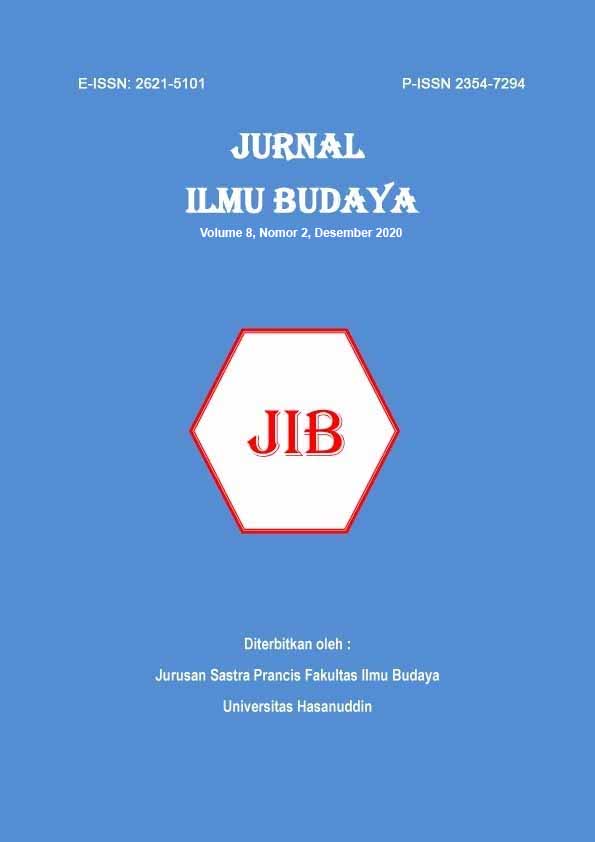SEMIOTIKA KARIKATUR PANDEMI COVID-19 MELALUI MEDIA DARING (ON LINE) DI PERANCIS
DOI:
https://doi.org/10.34050/jib.v8i2.11106Keywords:
Caricature, Government, Optimism, Pessimism, ChinaAbstract
This study investigates the caricature representations contained in online media regarding the French government's response to the Covid-19 Pandemic. Also examined the response of citizens to government policies, including religious and other professional society. This research was conducted to try to examine aspects of Corona pandemic reporting through online media because this issue has become a worldwide concern. Pandemic has caused many victims The response of the community is directly reflected in the caricature. by using the semiotic approach, we will get the meanings of the caricatures under study. The caricature is the data in this study. Caricature as data is divided into four: caricature of the government version, caricature of the community version, caricature of the professional version and caricature which is a critique of the Chinese government scientific method used is semiotics as a theory that can interpret the explicit and implicit meaning of an image. The results of the study found that the French Government remained criticized despite trying to handle the pandemic to the maximum. Also depicted a sense of optimism and pessimism of citizens facing disaster. Also found criticism of the Chinese Government that is not open to investigations of the origin of the virus.References
Abbas, Lutfi. Linguistik Bahasa Indonesia Cet.1. Bandung: Universitas Padjajaran, 1967.
Barthes, Roland. 1968. Elements of Semiology. New York: Hill and Wang Bauer, Laurie. Introducing Linguistics Morphology. Great Britain: Edinburgh University Press, 1988.
Berger, Arthur Asa. Semiotika : Tanda-tanda dalam Kebudayaan Kontemporer. Jakarta: Tiara Wacana, 2015.
Christomy. "Semiotika Budaya." In Semiotika Budaya, by Yuwono, 117. Depok: Pusat Penelitian Kemasyarakatan dan Budaya UI, 2004.
Danesi, Marcel. Pesan Tanda dan Makna. Yogyakarta: Jalasutra, 2004.
Hoed, Benny. Semiotik dan Dinamika Sosial Budaya. Depok: Fakultas Ilmu Budaya UI, 2011.
Mahsun. Metode Penelitian Bahasa: Tahapan Strategi, metode, dan tekniknya. Edisi Revisi Cet.8. Jakarta: Rajawali Press, 2014.
Matthews, P.H. Morphology: An Introduction to the Theory of World Structure. London: Cambridge University Press, 1974.
Moleong, Lexy. "Metodologi Penelitian Kualitatif." In Metodologi Penelitian Kualitatif, by Lexy Moleong, 103. Bandung: PT. Remaja Rosdakarya., 2002.
Noth, Winfried. Semiotik. Terjemahan oleh Dharmajo, Jumadi, Eti Setiawati, Aleda Mawene. Malang: Airlangga University Press, 2006.
Purnanto, Dwi. "Kajian Morfologi Derivasional dan Infleksional." Kajian Linguistik dan Sastra Vol.18, no 35, 2006: 136-152.
Rayya, Helfina. Telaah Konsep Semiotik Ferdinand de Saussure, Tth: 14.
Saussure, de Ferdinand. Course In General Linguistics. Paris: Payot, 1990.
Sebeok, Tomas. "Perfussion of Signs." "Perfussion of Signs" Vol. 55, No 1, 1979. Vol. 3, No 2 (Universitas Muhammadiyah Yogyakarta), 2014.
Sudaryanto. Metode dan Teknik Analisis Bahasa. Yogyakarta: Sanata Dharma University Press, 2018.
Supriadi, S., Maknun, T., Said, I.M. 2019. Karikatur Politik dalam Media Cetak Harian Rakyat Sulsel: Kajian Semiotik. Jurnal Ilmu Budaya, 7 (1), 134-145
Usman, Moses. Alat Penganalisis bahasa-Bahasa di Dunia Morfologi dan Sintaksis. makassar: Alauddin University Press, 2013.
Zoest, Aart Van. Semiotika: Tentang Tanda, Cara Kerjanya dan Apa yang Kita Lakukan dengannya. Jakarta: Yayasan Sumber Agung, 1993.
Sumber daring:
Charlie Hebdo
Le Monde
Sputnik. Fr
Downloads
Published
Issue
Section
License
Copyright (c) 2020 JURNAL ILMU BUDAYA

This work is licensed under a Creative Commons Attribution-NonCommercial 4.0 International License.


